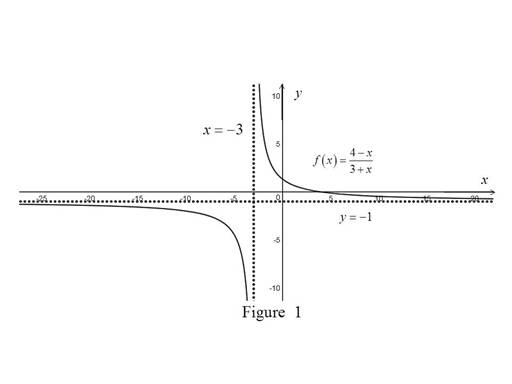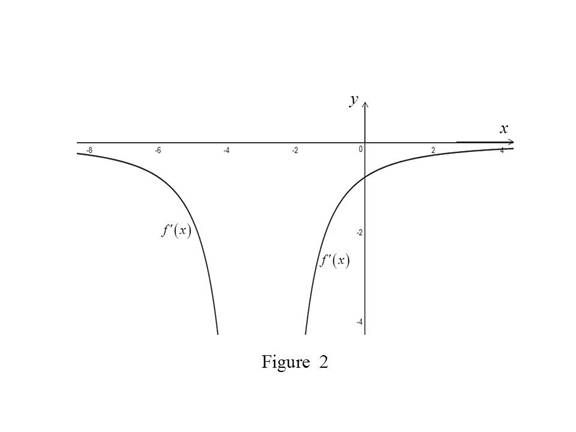
(a)
To find: The asymptotes of the graph of
(a)
Answer to Problem 38RE
The vertical asymptote is
Explanation of Solution
Calculation:
Recall that the line
Take limit on the above.
Thus, the horizontal asymptote is
Recall that the line
Thus, the vertical asymptote is
Graph:
Use the above information and trace the graph of

Observation:
(b)
To sketch: The graph of
(b)
Explanation of Solution
Calculation:
From the above graph in part a,
it is cleared that
Both the two disjoint curves of f have negative slope.
Thus, the graph of
For the curve present below the y-axis,
the value of the slope decreases as the curve moves from left to right
approaching the line
Thus, the graph of
For the curve present above the y-axis,
the value of the slope increases as the curve moves from left to right
approaching the line
Thus, the graph of
Graph:
Use the information above and trace the graph of

(c)
To find: The derivative of
(c)
Answer to Problem 38RE
The derivative is
Explanation of Solution
Formula used:
The derivative of a function f, denoted by
Calculation:
Obtain the derivative of the function
Compute
Simplify the numerator in the above expression
Since the limit h approaches zero but not equal to zero, cancel the common term h from both the numerator and the denominator,
Thus, the value of the derivative is
(d)
To sketch: The graph of
(d)
Explanation of Solution
Graph:
Use an online graphing calculator to sketch the graph of

Observation:
From Figure 3, it has been observed that
Comparison:
The function in Figure 3 seems to be the same graph which was sketched in part b.
Chapter 2 Solutions
Single Variable Calculus: Concepts and Contexts, Enhanced Edition
- = 5 37 A 4 8 0.5 06 9arrow_forwardConsider the following system of equations, Ax=b : x+2y+3z - w = 2 2x4z2w = 3 -x+6y+17z7w = 0 -9x-2y+13z7w = -14 a. Find the solution to the system. Write it as a parametric equation. You can use a computer to do the row reduction. b. What is a geometric description of the solution? Explain how you know. c. Write the solution in vector form? d. What is the solution to the homogeneous system, Ax=0?arrow_forward2. Find a matrix A with the following qualities a. A is 3 x 3. b. The matrix A is not lower triangular and is not upper triangular. c. At least one value in each row is not a 1, 2,-1, -2, or 0 d. A is invertible.arrow_forward
- Find the exact area inside r=2sin(2\theta ) and outside r=\sqrt(3)arrow_forwardA 20 foot ladder rests on level ground; its head (top) is against a vertical wall. The bottom of the ladder begins by being 12 feet from the wall but begins moving away at the rate of 0.1 feet per second. At what rate is the top of the ladder slipping down the wall? You may use a calculator.arrow_forwardExplain the focus and reasons for establishment of 12.4.1(root test) and 12.4.2(ratio test)arrow_forward
- Use 12.4.2 to determine whether the infinite series on the right side of equation 12.6.5, 12.6.6 and 12.6.7 converges for every real number x.arrow_forwarduse Cauchy Mean-Value Theorem to derive Corollary 12.6.2, and then derive 12.6.3arrow_forwardExplain the focus and reasons for establishment of 12.5.4arrow_forward
 Calculus: Early TranscendentalsCalculusISBN:9781285741550Author:James StewartPublisher:Cengage Learning
Calculus: Early TranscendentalsCalculusISBN:9781285741550Author:James StewartPublisher:Cengage Learning Thomas' Calculus (14th Edition)CalculusISBN:9780134438986Author:Joel R. Hass, Christopher E. Heil, Maurice D. WeirPublisher:PEARSON
Thomas' Calculus (14th Edition)CalculusISBN:9780134438986Author:Joel R. Hass, Christopher E. Heil, Maurice D. WeirPublisher:PEARSON Calculus: Early Transcendentals (3rd Edition)CalculusISBN:9780134763644Author:William L. Briggs, Lyle Cochran, Bernard Gillett, Eric SchulzPublisher:PEARSON
Calculus: Early Transcendentals (3rd Edition)CalculusISBN:9780134763644Author:William L. Briggs, Lyle Cochran, Bernard Gillett, Eric SchulzPublisher:PEARSON Calculus: Early TranscendentalsCalculusISBN:9781319050740Author:Jon Rogawski, Colin Adams, Robert FranzosaPublisher:W. H. Freeman
Calculus: Early TranscendentalsCalculusISBN:9781319050740Author:Jon Rogawski, Colin Adams, Robert FranzosaPublisher:W. H. Freeman
 Calculus: Early Transcendental FunctionsCalculusISBN:9781337552516Author:Ron Larson, Bruce H. EdwardsPublisher:Cengage Learning
Calculus: Early Transcendental FunctionsCalculusISBN:9781337552516Author:Ron Larson, Bruce H. EdwardsPublisher:Cengage Learning





